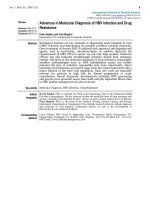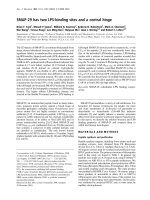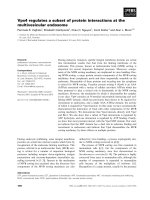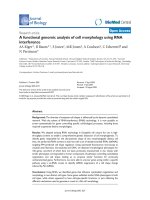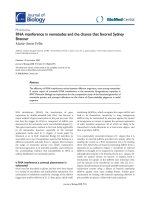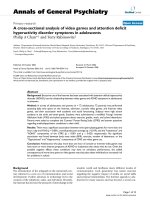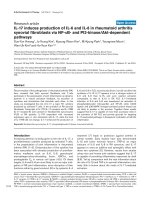Báo cáo y học: "RNA interference pinpoints regulators of cell size and the cell cycle" doc
Bạn đang xem bản rút gọn của tài liệu. Xem và tải ngay bản đầy đủ của tài liệu tại đây (60.68 KB, 3 trang )
Genome Biology 2006, 7:219
comment
reviews
reports deposited research
interactions
information
refereed research
Minireview
RNA interference pinpoints regulators of cell size and the cell
cycle
Megan J Cully* and Sally J Leevers
†
Addresses: *Signal Transduction Laboratory and
†
Growth Regulation Laboratory, Cancer Research UK London Research Institute, 44
Lincoln’s Inn Fields, London WC2A 3PX, UK.
Correspondence: Sally J Leevers. Email:
Abstract
Cell-based genome-wide RNA interference screens are being used to address an increasingly
broad spectrum of biological questions. In one recent screen, Drosophila cell cultures treated with
double-stranded RNA were analyzed by flow cytometry, providing a wealth of new information
and identifying 488 regulators of the cell cycle, cell size, and cell death.
Published: 30 May 2006
Genome Biology 2006, 7:219 (doi:10.1186/gb-2006-7-5-219)
The electronic version of this article is the complete one and can be
found online at />© 2006 BioMed Central Ltd
The growth of an organism is the net result of a variety of
processes, including changes in cell size, cell division and
apoptosis. These processes are regulated by intricate, inter-
related molecular networks, and their disruption can have
major biological consequences. In particular, the relation-
ship between changes in cell size and the cell cycle has long
fascinated researchers. It is complex, poorly understood, and
varies according to the organism, tissue type and develop-
mental context. In yeast, large-scale genetic screens have
uncovered many genes involved in cell growth and the initia-
tion of DNA synthesis (S phase) [1,2]. It is now clear that
yeast cells must grow to a certain minimal size before start-
ing DNA synthesis, providing a ‘cell size checkpoint’ at the
transition from the preceding G1 phase to S phase (the G1/S
transition). Yeast is a unicellular organism, however, and
there is increasing evidence that the relationship between
cell growth and cell division may be different in metazoans.
Excitingly, recent technical advances in high-throughput RNA
interference (RNAi) mean that large-scale screening
approaches, somewhat analogous to the genetic screens in
yeast, can now be applied to cultured metazoan cells.
Drosophila hemocyte cell lines have emerged as popular cell
systems for this experimental approach for a number of
reasons. First, they are very amenable to RNAi mediated by
double-stranded RNA (dsRNA): dsRNA molecules of more
than 500 bp can be easily introduced into these cells and are
rapidly processed into short interfering RNAs (siRNAs).
Second, there are significantly fewer genes in Drosophila than
in mammals, making the mammoth undertaking of a genome-
wide screen a little less daunting. Finally, there is less genetic
redundancy in Drosophila than in mammals, so depletion of
just one gene is more likely to reveal a phenotype.
Genomic screens for the total complement of protein kinases
(the kinome) and general genome-wide screens have been
performed in Drosophila cell cultures using diverse readouts
such as cell shape, resistance to bacterial infection and tran-
scriptional activity [3-8]. Bjorklund et al. [9] have recently
published one of the most comprehensive screens to date, in
which they searched on a genome-wide scale for dsRNAs
that alter cell size, cell-cycle distribution and cell death. The
dataset they generated provides an excellent starting point
for many new avenues of research. At the same time, this
massive undertaking highlights some of the bioinformatic
challenges associated with screens on this scale. For
example, the data generated can be analyzed and presented
in various ways to highlight the different phenotypic effects
(see the supplementary data accompanying [9]).
The Taipale lab [9] used dsRNAs corresponding to 11,971
individual cDNAs to target the silencing of approximately
70% of known Drosophila genes. After 4 days culture, flow-
cytometry profiles were generated for each dsRNA treatment
in triplicate to provide information on the distribution of
cells in different phases of the cell cycle as well as cell size.
The simultaneous effect of each dsRNA on six different cel-
lular phenotypes was recorded: the percentage of cells with a
DNA content of 2N (percentage of cells in G1; 2N denotes
cells in G1); 4N cells (percentage of cells in G2, the phase
after the DNA has been replicated); less than 2N (percentage
of dying cells); and greater than 4N (percentage of cells with
defective cytokinesis); as well as the average cell size of the
G1 population (G1 cell size), and the G2 population (G2 cell
size). A dsRNA was considered a ‘hit’ if it changed one of
these percentages relative to control cells by more than 5
standard deviations. The phenotypes of all the hits were then
clustered using an unbiased approach, allowing the authors
to identify groups of genes whose downregulation results in
similar phenotypes. In many cases, genes with similar
known functions clustered tightly together, but a number of
new or unexpected groups of genes were also identified.
Identifying genes involved in cell-cycle
progression
One major aim of the screen by Bjorklund et al. [9] was to
identify genes involved in cell-cycle progression by screening
for dsRNAs that alter the proportion of cells in different
phases of the cell cycle. Although these data are informative
in themselves, more can be learnt when they are combined
with data on any simultaneous changes in cell number. This
is best illustrated by an example. dsRNAs can increase the
percentage of cells in G1 either by delaying progression from
G1 to S phase or by accelerating progression through M
phase (mitosis), and cell-number data can distinguish
between these two possibilities. Cyclin E is known to
promote the transition from G1 into S phase, and its deple-
tion increased the proportion of cells in G1, presumably by
delaying their progression into S phase. Such an effect would
have been accompanied by a reduction in cell number. The
protein kinase Wee1 inhibits progression through G2 and M
phase, and its depletion also increased the proportion of
cells in G1. In this case, however, the increased percentage of
the population in G1 is likely to reflect accelerated progres-
sion through M phase, and would therefore be accompanied
by an increase in cell number. Unfortunately, high-through-
put flow cytometry does not allow the simultaneous collec-
tion of reliable cell-number data. The current dataset might
be fruitfully exploited, however, by identifying the dsRNAs
that altered cell-cycle distribution, and then carrying out a
secondary screen of those dsRNAs to determine their effect
on cell number.
Silencing of genes encoding components of the small and
large ribosomal subunits resulted in cellular phenotypes that
clustered into three distinct groups. dsRNAs corresponding
to one group of ribosomal proteins increased the percentage
of cells in G1, decreased the percentage of cells in G2,
increased the percentage of cells undergoing apoptosis and
decreased both G1 and G2 cell size. It is tempting to specu-
late that these cells are impaired in their ability to synthesize
proteins and progress more slowly through G1/S, perhaps
because of reduced G1 cyclin synthesis. They are also
impaired in their ability to grow, consistent with the known
role of protein synthesis in cell growth; the increase in apop-
tosis may be due to a reduction in the translation of proteins
necessary for cell survival. Depletion of the second group of
ribosomal proteins seemed to cause a G1 arrest, as it
resulted in an even more marked increase in the G1 popula-
tion at the expense of the G2 population, with little effect on
apoptosis and no effect on cell size. Finally, dsRNAs corre-
sponding to a third group of ribosomal proteins increased
apoptosis but had no effect on the cell cycle or cell size.
While it is possible that the ribosomal proteins in these dif-
ferent groups have different functions, it is perhaps more
likely that the different phenotypes simply reflect different
efficiencies of RNAi. For example, slightly decreased ribo-
some function might result in a G1 arrest, whereas complete
ablation of ribosome function might induce apoptosis irre-
spective of the cell-cycle phase. Thus, the group with a pri-
marily apoptotic phenotype would contain the most effective
dsRNAs, whereas the group with a cell-cycle arrest-like phe-
notype would contain the least effective dsRNAs. To test this
hypothesis, one could treat Drosophila S2 cells with increas-
ing amounts of dsRNA corresponding to representative ribo-
somal proteins from each of the three groups in an attempt
to reproduce all three phenotypes.
Identifying genes that regulate cell size
Another aim of the screen was to identify genes whose down-
regulation alters cell size. Becuase cells grow as they
progress through the cell cycle, dsRNAs that increase the
proportion of cells in G2 will also increase the mean cell size
of the entire cell sample without necessarily having an inde-
pendent effect on cell growth. Bjorklund et al. [9] got round
this problem by gating the flow-cytometry data and analyz-
ing the size of cells in G1 and G2 separately. A number of
genes were identified whose depletion increased both G1 and
G2 cell size without having any effect on the distribution of
cells in the cell cycle. In theory, these genes might represent
proteins which, when depleted, allow increased growth, or
proteins whose depletion delays cell-cycle progression
without having an effect on growth or the distribution of
cells in the cell cycle. These two possibilities could be distin-
guished by examining the effect of these dsRNAs on cell
number. Intriguingly, many of these hits for increased cell
size were identified by Computed Gene (CG) numbers only
(the CG nomenclature refers to genes of unknown function).
The way in which these genes affect cell size is hard to
predict but may represent an untapped source of informa-
tion. Some of these genes contain identifiable protein
domains and have potential orthologs in other organisms;
219.2 Genome Biology 2006, Volume 7, Issue 5, Article 219 Cully and Leevers />Genome Biology 2006, 7:219
thus, their functions may also be conserved. Some, for
example, are homologous to known transcription factors;
CG5684 and CG1884 are similar to components of the
general transcriptional machinery, while CG1024 and
CG18081 resemble zinc finger proteins.
The insulin signaling pathway leading to activation of the
protein kinase Tor is a well known regulator of growth and
can alter cell size in both Drosophila and mammals [10].
Activating insulin/Tor signaling increases cell and organism
size, whereas inhibiting this pathway has the opposite effect.
Despite the well known role of this signaling pathway in cell-
size regulation, only one of its known components, Tsc1, was
identified by Bjorklund et al. [9]. Tsc1 is a negative regulator
of the insulin/Tor pathway, so its depletion is predicted to
increase cell size. Although dsRNA-mediated RNAi silencing
of the Tsc1 gene did cause a modest increase in G1 and G2
cell size, it also caused defective cytokinesis, and hence Tsc1
clustered with other genes whose downregulation gave a
phenotype including defective cytokinesis. By searching
through the data manually, Bjorklund et al. [9] found that
dsRNA-mediated RNAi against eight other components of
the insulin/Tor pathway gave weak but detectable pheno-
types. Surprisingly though, they primarily affected the cell
cycle rather than cell size. Activation of this pathway in vivo,
through the mutation of negative regulators or the over-
expression of positive regulators, decreases the proportion of
cells in G1 and increases the proportion of cells in S phase
and G2/M [11-13]. Conversely, inhibiting the pathway
increases the proportion of cells in G1 [13]. The data pro-
vided by this RNAi screen are consistent with these observa-
tions: inactivation of the pathway reduced the proportion of
cells in G1. It is, however, unclear why depletion of the pro-
teins on this pathway had such a weak effect on cell size -
modulation of the insulin pathway in Drosophila S2 cells by
dsRNA-mediated RNAi can induce changes in cell size of
more than 25% ([14] and M.J.C. and S.J.L., unpublished
observations). Perhaps different culture conditions, varia-
tion among S2 cell lines, or different RNAi efficiencies are
responsible for this difference in sensitivity.
Although increasing numbers of dsRNA-mediated RNAi
screens with similar phenotypic readouts are being per-
formed, there is relatively little overlap between the gene
sets identified. This lack of overlap may result partly from
false negatives due to low RNAi efficiency and the inherent
problems associated with targeting stable proteins. In addi-
tion, false positives may have been generated by off-target
effects. The dsRNA library used by Bjorklund et al. [9] was
produced using full-length cDNA templates, so off-target
effects (generated when a stretch of 21 bp or more in the
dsRNA is identical to another transcript) may be substantial.
No doubt, the ongoing generation of large, searchable data-
bases containing data from different RNAi screens will
become crucial to interpreting the results of these genomic
approaches [8]. Correlation of the rich dataset generated by
Bjorklund et al. [9] with related screens, both past and
future, should help to clarify the roles of many molecular
networks that act together to regulate growth, cell size and
the cell cycle.
References
1. Jorgensen P, Nishikawa JL, Breitkreutz BJ, Tyers M: Systematic
identification of pathways that couple cell growth and divi-
sion in yeast. Science 2002, 297:395-400.
2. Nurse P: Genetic control of cell size at cell division in yeast.
Nature 1975, 256:547-551.
3. Agaisse H, Burrack LS, Philips JA, Rubin EJ, Perrimon N, Higgins DE:
Genome-wide RNAi screen for host factors required for
intracellular bacterial infection. Science 2005, 309:1248-1251.
4. Boutros M, Kiger AA, Armknecht S, Kerr K, Hild M, Koch B, Haas
SA, Paro R, Perrimon N, Heidelberg Fly Array Consortium:
Genome-wide RNAi analysis of growth and viability in
Drosophila cells. Science 2004, 303:832-835.
5. DasGupta R, Kaykas A, Moon RT, Perrimon N: Functional
genomic analysis of the Wnt-wingless signaling pathway.
Science 2005, 308:826-833.
6. Kiger AA, Baum B, Jones S, Jones MR, Coulson A, Echeverri C, Perri-
mon N: A functional genomic analysis of cell morphology
using RNA interference. J Biol 2003, 2:27.
7. Bettencourt-Dias M, Giet R, Sinka R, Mazumdar A, Lock WG,
Balloux F, Zafiropoulos PJ, Yamaguchi S, Winter S, Carthew RW, et
al.: Genome-wide survey of protein kinases required for cell
cycle progression. Nature 2004, 432:980-987.
8. Sims D, Bursteinas B, Gao Q, Zvelebil M, Baum B: FLIGHT: data-
base and tools for the integration and cross-correlation of
large-scale RNAi phenotypic datasets. Nucleic Acids Res 2006,
34(Database issue):D479-D483.
9. Bjorklund M, Taipale M, Varjosalo M, Saharinen J, Lahdenpera J,
Taipale J: Identification of pathways regulating cell size and
cell-cycle progression by RNAi. Nature 2006, 439:1009-1013.
10. Leevers SJ, Hafen, E: Growth regulation by insulin and TOR
signaling in Drosophila. In Cell Growth: Control of Cell Size. Edited by
Hall MN, Raff M, Thomas G. Cold Spring Harbor Laboratory Press,
New York; 2004:167-192.
11. Gao X, Neufeld TP, Pan D: Drosophila PTEN regulates cell
growth and proliferation through PI3K-dependent and -
independent pathways. Dev Biol 2000, 221:404-418.
12. Tapon N, Ito N, Dickson BJ, Treisman JE, Hariharan IK: The
Drosophila tuberous sclerosis complex gene homologs
restrict cell growth and cell proliferation. Cell 2001, 105:345-
355.
13. Weinkove D, Neufeld TP, Twardzik T, Waterfield MD, Leevers SJ:
Regulation of imaginal disc cell size, cell number and organ
size by Drosophila class I(A) phosphoinositide 3-kinase and
its adaptor. Curr Biol 1999, 9:1019-1029.
14. Patel PH, Thapar N, Guo L, Martinez M, Maris J, Gau CL, Lengyel JA,
Tamanoi F: Drosophila Rheb GTPase is required for cell cycle
progression and cell growth. J Cell Sci 2003, 116:3601-3610.
comment
reviews
reports deposited research
interactions
information
refereed research
Genome Biology 2006, Volume 7, Issue 5, Article 219 Cully and Leevers 219.3
Genome Biology 2006, 7:219
